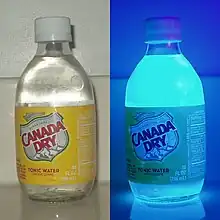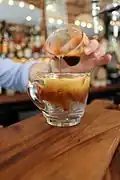
Tonic water (or Indian tonic water) is a carbonated soft drink in which quinine is dissolved. Originally used as a prophylactic against malaria, nowadays tonic water usually has a significantly lower quinine content and is often sweetened. It is consumed for its distinctive bitter flavor and is frequently used in mixed drinks, particularly in gin and tonic.
History
As early as the 17th century the Spanish used quinine from the bark of Cinchona trees to treat malaria after being shown the remedy from the Indigenous peoples of Peru, Bolivia, and Ecuador.[1]
In early 19th century India and other tropical posts of the British Empire, medicinal quinine was recommended to British officials and soldiers to prevent malaria,[2] where it was mixed with soda and sugar to mask its bitter taste, creating tonic water.
The first commercial tonic water was produced in 1858 when it was patented by the owner of Pitt & Co., Erasmus Bond.[3][4] The mixed drink gin and tonic also originated in British colonial India, when the British mixed their medicinal quinine tonic with gin and other ingredients to make the bitter medicine more palatable.[5] Soldiers in India were already given a gin ration, so the sweet concoction was easy to make.[6] In 1868, the first known record of a gin and tonic was in the Oriental Sporting Magazine and was described as a refreshing cocktail for spectators of horse racing, not as a medicine.[7]
Quinine content
Medicinal tonic water originally contained only carbonated water and a large amount of quinine. Most modern tonic waters contain comparatively less quinine, and are often enhanced by citrus flavors. As a result of the lower quinine content, tonic water is less bitter. It is also usually sweetened, often with the addition of high-fructose corn syrup or sugar. Some manufacturers also produce diet (or "slimline") tonic water, which may contain artificial sweeteners such as aspartame. Traditional-style tonic water with high amounts of quinine and carbonated water is less common, but may be preferred by those who desire the bitter flavor.
In the United States, the US Food and Drug Administration (FDA) limits the quinine content in tonic water to 83 ppm[8] (83 mg per liter), while the daily therapeutic dose of quinine is in the range of 500–1000 mg,[9] and 10 mg/kg every eight hours for effective malaria prevention (2,100 mg daily for a 70-kilogram (150 lb) adult).[10] Until about 2010,[11] quinine was often recommended as a relief for leg cramps, although medical research suggested some care was needed in monitoring doses.[12] Because of quinine's risks, the FDA cautions consumers against using "off-label" quinine drugs to treat leg cramps.[13]
Use



Tonic water is often used as a drink mixer for cocktails, especially gin and tonic. Vodka tonic is also popular. Tonic water with lemon or lime juice added is often known as bitter lemon or bitter lime. It is popular for its signature bitter but sweet taste. Another use of tonic water is in coffee. The espresso and tonic was created in Helsingborg, Sweden, at Koppi Roasters after a staff party where they mixed tonic water, syrup, and an espresso. Since 2007, the drink has grown in popularity in Scandinavia, Europe, and the United States.[14]
Negative effects
Tonic water is known to cause fixed eruptions, which is a type of skin reaction to drugs,[15] due to the quinine content. Various scientific journals have reported the repeated intake of tonic water can cause fixed eruptions with varying severity, with one reporting the onset of Stevens–Johnson syndrome.[16] The cases of fixed eruptions were seen after the patients drank tonic water, by itself or mixed with gin. Some symptoms of the fixed eruptions include pigmented macules, high fever, erythematous plaques, and bullous.[17][18]
Fluorescence
The quinine in tonic water will fluoresce under ultraviolet light. In fact, quinine will visibly fluoresce in direct sunlight against a dark background.[19] The quinine molecules release energy as light instead of heat, which is more common. The state is not stable and the molecules will eventually return to a ground state and no longer glow.[20]
See also
References
- ↑ Achan, Jane; Talisuna, Ambrose O; Erhart, Annette; Yeka, Adoke; Tibenderana, James K; Baliraine, Frederick N; Rosenthal, Philip J; D'Alessandro, Umberto (24 May 2011). "Quinine, an old anti-malarial drug in a modern world: role in the treatment of malaria". Malaria Journal. 10: 144. doi:10.1186/1475-2875-10-144. ISSN 1475-2875. PMC 3121651. PMID 21609473.
- ↑ "The Hidden Ingredient In Tonic Water You Should Know About". mindbodygreen. 5 July 2018. Retrieved 21 January 2022.
- ↑ Raustiala, Kal (28 August 2013). "The Imperial Cocktail". Slate. The Slate Group. Retrieved 30 August 2013.
- ↑ "Just the tonic: A natural history of tonic water | Kew". www.kew.org. Retrieved 21 January 2022.
- ↑ "Tonic water: sweet, bitter medicine. - Free Online Library". www.thefreelibrary.com. Retrieved 30 December 2009.
- ↑ Raustiala, Kal (28 August 2013). "Gin and tonic kept the British Empire healthy: The drink's quinine powder was vital for stopping the spread of malaria". Slate.com. Retrieved 25 June 2014.
- ↑ Keel, Toby (19 October 2019). "Curious Questions: Who invented the gin and tonic?". Country Life. Retrieved 4 February 2022.
- ↑ "21 CFR §172.575 Quinine" (PDF). gpo.gov. Archived (PDF) from the original on 19 April 2009. Retrieved 15 December 2008.
- ↑ "Quinine". Tropical Plant Database. Section "Current practical uses": Raintree Nutrition. Retrieved 10 July 2011.
- ↑ Achan, J (2011). "Quinine, an old anti-malarial drug in a modern world: role in the treatment of malaria". Malaria Journal. 10 (144): 1–12. doi:10.1186/1475-2875-10-144. PMC 3121651. PMID 21609473.
- ↑ "FDA Drug Safety Communication: New risk management plan and patient Medication Guide for Qualaquin (quinine sulfate)". U.S. Food and Drug Administration (FDA). 7 August 2010. Archived from the original on 19 February 2011. Retrieved 21 February 2011.
- ↑ Brasić, JR (1999). "Should people with nocturnal leg cramps drink tonic water and bitter lemon?". Psychol Rep. 84 (2): 355–67. doi:10.2466/pr0.1999.84.2.355. PMID 10335049. S2CID 42278918.
- ↑ "FDA Advances Effort Against Marketed Unapproved Drugs: FDA Orders Unapproved Quinine Drugs from the Market and Cautions Consumers About Off-Label Quinine to Treat Leg Cramps". United States Food and Drug Administration. 11 December 2006. Archived from the original on 13 January 2017. Retrieved 26 April 2017.
{{cite web}}: CS1 maint: bot: original URL status unknown (link) - ↑ "Espresso&Tonic: The Story of the Famous Coffee Drink". European Coffee Trip. 3 August 2018. Retrieved 9 February 2022.
- ↑ Shiohara, Tetsuo. "Fixed Drug Eruption". Up To Date. Retrieved 21 January 2022.
- ↑ Wada (20 May 2021). "Stevens-Johnson syndrome induced by tonic water". Journal of the European Academy of Dermatology and Venereology. 35 (10): e662–e663. doi:10.1111/jdv.17368. PMID 34014581. S2CID 234793002. Retrieved 21 January 2022.
- ↑ Bel, Blandine (12 October 2009). "Fixed eruption due to quinine contained in tonic water: positive patch-testing". Contact Dermatitis. 61 (4): 242–244. doi:10.1111/j.1600-0536.2009.01617.x. PMID 19825101. S2CID 673226. Retrieved 21 January 2022.
- ↑ Ohira, Aoi (3 June 2013). "Fixed eruption due to quinine in tonic water: A case report with high-performance liquid chromatography and ultraviolet A analysis". The Journal of Dermatology. 40 (8): 629–631. doi:10.1111/1346-8138.12195. PMID 23724855. S2CID 21534602. Retrieved 21 January 2022.
- ↑ Steve Fentress (9 August 2011). "The Blue Glow Of Quinine". indianapublicmedia.org. Retrieved 16 February 2020.
- ↑ "Shining Science: Explore Glow-in-the-Dark Water!". Scientific American. Retrieved 4 February 2022.
External links
 The dictionary definition of tonic water at Wiktionary
The dictionary definition of tonic water at Wiktionary Media related to Tonic water at Wikimedia Commons
Media related to Tonic water at Wikimedia Commons